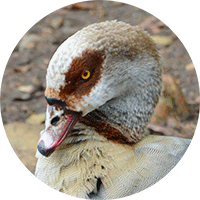Orinoco Goose
Physical Appearance: The Orinoco Goose has a unique and striking appearance. It is a medium-sized goose measuring around 69 cm (27 inches) in length. Their plumage is dark grey, with a lighter grey and white coloration on the head and neck. They have large, webbed feet and a stout bill.
Habitat and behavior: These geese prefer freshwater habitats with dense vegetation where they can find cover at altitudes of 500-2600 m. They are not highly migratory and tend to be sedentary, residing in their preferred wetland areas year-round. They are known to be social birds, often forming large flocks. during the breeding season. Grazes on plant matter.
Breeding: Orinoco Geese breed between October and March. They construct nests on the ground, near the water's edge, using plant material and lined with down feathers. Females lay around 7-9 eggs, which they incubate for approximately 30 days. Both parents participate in raising the young.
Conservation: The Orinoco Geese face threats from disturbance from human activities. Nevertheless, they are listed as a species of concern/vulnerable by the International Union for Conservation of Nature (IUCN).
Distribution
The Llanos Region: The Orinoco goose is known to inhabit the Llanos region or the Los Llanos Orientales, which encompasses parts of eastern Colombia and western Venezuela. This vast lowland area is dominated by grasslands, wetlands, and seasonal flooding, creating suitable habitats for the species.
Wetlands and Rivers: Within Colombia, the Orinoco goose is typically associated with wetlands, rivers, and their surrounding areas. It can be found in marshes, flooded grasslands, and wooded riversides that offer a combination of open water, suitable vegetation, and nesting sites.
Taxonomy
- Kingdom: Animalia (animals)
- Phylum: Chordata (chordates)
- Class: Aves (birds)
- Order: Anseriformes (waterfowl)
- Family: Anatidae (ducks, geese, and swans)
- Genus: Oressochen
- Species: Oressochen jubatus
Vocalization
Honking: The most commonly heard vocalization of the Orinoco goose is a distinctive honking sound. The honk is a loud, resonant call that is often described as a low-pitched "honk" or "huhonk." This call is believed to serve as a means of communication between individuals, especially during flight or to establish territory boundaries.
Trumpeting: The goose also produces a characteristic trumpeting sound, which can be a series of short, sharp notes or a prolonged, melodious sound. This vocalization is often associated with courtship or territorial displays and may serve as a signal to attract mates or communicate with other geese in the vicinity.
Hissing: When threatened or alarmed, the Orinoco goose may emit a hissing noise. This sound is created by expelling air through its bill and is often accompanied by defensive posturing, such as raising the head, extending the neck, or fluffing the feathers as a warning to potential threats.





